Paul Poberezny Officiates at Historic Ceremony
By ANN Correspondent RC Jones
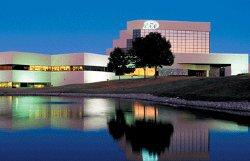 On a
cold evening a little over a week ago, in the Eagle
hanger of the EAA Museum (right), the 390 seats were filled to
listen to the founder of EAA, Paul Poberezny (shown, top, in 1953),
talk of the P-51 Mustang and derivitives flown by him in the last
65+ years. Many of the former and present EAA personnel, docents,
EAA members, friends and family were on hand for the
presentation.
On a
cold evening a little over a week ago, in the Eagle
hanger of the EAA Museum (right), the 390 seats were filled to
listen to the founder of EAA, Paul Poberezny (shown, top, in 1953),
talk of the P-51 Mustang and derivitives flown by him in the last
65+ years. Many of the former and present EAA personnel, docents,
EAA members, friends and family were on hand for the
presentation.
Scotland's Adam Smith (the museum's director for the past two
years), first commented on the the usual Wisconsin winter (the cold
and snow), and then noted Paul has flown all models of the P-51
(including the experimental version) during WWII, and before and
after Korea. He then introduced Tom Poberezny.
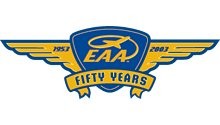 Fifty
years ago, EAA's first meeting was in the Gran Aire hanger at
Timmerman field in the northwest quadrant of the Milwaukee,
Wisconsin area. That part of the hanger was the 'dope and fabric'
room, now used for flight training. Tom introduced his mother,
Audrey, sister, Bonnie, and the guest of honor: his father,
Paul.
Fifty
years ago, EAA's first meeting was in the Gran Aire hanger at
Timmerman field in the northwest quadrant of the Milwaukee,
Wisconsin area. That part of the hanger was the 'dope and fabric'
room, now used for flight training. Tom introduced his mother,
Audrey, sister, Bonnie, and the guest of honor: his father,
Paul.
The younger Poberezny commented on the fact he
had introduced his father twice in the last six weeks,
most-recently for the presentation of the Wright Memorial trophy
(given out only once a year, in the last fifty-five years, to
respected aviation notables). Paul was presented the trophy for
Recreational Aviation last December 13. Family, friends, and local
EAA-ers were in the audience. Past recipients of the Wright Trophy
include Charles Lindburgh, Donald Douglas, Jimmy Doolittle, Igor
Sikorsky, Kelly Johnson, Olive Beech, and Charles Kaman, among
others. The award is to be placed in the lobby of EAA's museum next
to the statue of Paul Poberezny, to be shared by all aviation
enthusiasts.
Kick-starting a legend:
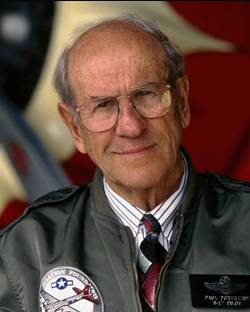 Paul Poberezny (last year, right), the founder and
first president of EAA, started by saying he was a poor student in
his early years but had a keen interest in building model aircraft.
In high school, one teacher saw Paul was interested in airplanes
more than the usual subjects. Knowing this, the teacher gave Paul a
wrecked glider and $67 to fix it up.
Paul Poberezny (last year, right), the founder and
first president of EAA, started by saying he was a poor student in
his early years but had a keen interest in building model aircraft.
In high school, one teacher saw Paul was interested in airplanes
more than the usual subjects. Knowing this, the teacher gave Paul a
wrecked glider and $67 to fix it up.
Young Paul did a lot of reading then -- flying magazines
and how-to books gave Paul the basics of how to repair the glider.
Paul learned, practiced, and applied skills in welding and
fabricating tubing structures; and later he tackled dope and fabric
-- and not the EPA/OSHA-approved type of "dope" common today, just
the 'sweet smelling' kind. After the repairs on the glider were
complete, Paul learned to fly. By using the glider in his dad's
garage for studying aileron, elevator, and rudder movement, Paul
had a neighbor tow him in an old Whippet (car) until he
got 100 feet off the ground; then he cut loose the tow
rope, and flew for a while until the "hard landing," which meant
KEEP THE NOSE DOWN. If all goes well, Paul's glider, again
rebuilt, will be flown during the 2003 AirVenture.
Paul's first homebuilt, Little Poop Deck, was built in his
father's garage in 1952, and was flown locally around the Milwaukee
area. Paul met lots of local farmers due to forced
landings in that pioneer machine. Once, he flew into Brownie's
airport north of Milwaukee and was told to "get out of here or you
will be arrested" by the airport manager. (Homebuilts were
simply not allowed at the airport, much the way many of
today's airports are closed to anything that looks like an
ultralight.) Paul fixed a trim condition and took off, but had to
land in nearby West Bend (WI), and ultimately had to hitchhike
home. His parents were worried that he was gone for such a long
time. He remembered his wardrobe: a pair of Khakies, $1.98 for
pants and shirt. (The better ones went for $2.98.)
How to Start EAA:
Paul Poberezny had been thinking of starting a club in which
homebuilders could come together. He sent post cards of invitation
to local flyers, and 30 showed up on January 26, 1953. One of the
questions was, "What are the dues?" Paul answered, "Five dollars,"
not two dollars as suggested, to 'maintain stability' in the new
club.
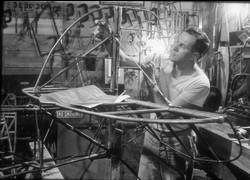 Not too long after that, Paul's exploits were
featured in Mechanix Illustrated magazine (right). That
article, on building an airplane, brought so much mail to his
house, the postman had no room left in the mailbox; the Pobereznys
had to open the door to accommodate the overflow.
Not too long after that, Paul's exploits were
featured in Mechanix Illustrated magazine (right). That
article, on building an airplane, brought so much mail to his
house, the postman had no room left in the mailbox; the Pobereznys
had to open the door to accommodate the overflow.
Some things don't change, and that's good.
Paul Poberezny, a self-described 'pack rat,' still has his
original typewriter and desk from the first meetings in Hales
Corners (WI).
The first fly-in was in 1953 at Timmerman field, where the
"fly-in" was held until 1955. In 1956, the growing event moved to
Rockford (IL). Having outgrown Rockford, the move was made to
Oshkosh for the 1970 fly-in, and it's been there ever since.
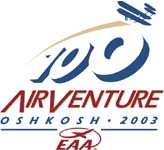 During 1970, chapters were formed, highlighting
respect for others; cleanliness and courtesy were stressed.
Thoughts of a museum was planned during those early years, with the
first one at Hales Corners. Later, in Oshkosh, a perfect site,
4½ acres, was for sale. Checking into the acreage, Paul met
with John Mark who owned the site, and explained what he wanted to
do with the project. The price was very reasonable, and John Mark
gave EAA an additional 3½ acres. EAA chapters were asked to
donate funds for the museum, which was completed in 1983. EAA's
headquarters was then moved to Oshkosh.
During 1970, chapters were formed, highlighting
respect for others; cleanliness and courtesy were stressed.
Thoughts of a museum was planned during those early years, with the
first one at Hales Corners. Later, in Oshkosh, a perfect site,
4½ acres, was for sale. Checking into the acreage, Paul met
with John Mark who owned the site, and explained what he wanted to
do with the project. The price was very reasonable, and John Mark
gave EAA an additional 3½ acres. EAA chapters were asked to
donate funds for the museum, which was completed in 1983. EAA's
headquarters was then moved to Oshkosh.
Paul didn't forsee the giant scope of what EAA would eventually
come to be, and over the years met with many pilots, astronauts,
and the varied people at the conventions, treasuring the moments
andtalking to the personalities over the years. The museum, and the
Wright Memorial Trophy belongs to the people involved with EAA.
Overload of cool machinery...
During his time in the Army Air Corps, Paul flew an A model, a B
model of the P-51, and a P-47 "Jug" in one day. He got into some
other neat machines, as well, like an A-24 SBD Dauntless
divebomber. Another time, he had the "ultimate dead-head" -- he
picked up a P-51, built on property that is now LAX, and
flew it to New Jersey for shipment overseas. They weren't all just
joyrides, though: the A36 version of the P-51 was a dive bomber
with dive brakes and a "stick" 3 inches longer for the leverage on
pullouts. Some of the early version had the wings come off which
neccessitated a healthy mod. For the Korean war, Paul changed to
the Air Force from the Army Air Corps.
How to wrangle a prototype Mustang...
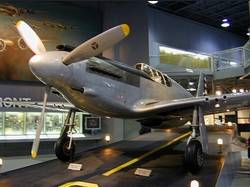 The
XP-51, serial number 4 (right) is in the museum now, with its
Allison engine, two guns in the nose under the prop, and six guns
in the wings. It was found at the Smithsonian's "junkyard" at
Silver Hill (MD). At the time, EAA had two Northrup "Alphas" on
hand, and the EAA managed a trade for the XP-51 which turned out to
be a wonderful find. (It was complete down to the clock.)
Restoration was undertaken, and the XP-51 was flown at many of the
early conventions. Last flown on August 2, 1982, the highly valued
plane was religated to museum duty after an engine problem, and
noting that the gear needed 28 seconds to come down, Paul nursed
her around the pattern at 25 inches of manifold pressure instead of
the usual 55 inches.
The
XP-51, serial number 4 (right) is in the museum now, with its
Allison engine, two guns in the nose under the prop, and six guns
in the wings. It was found at the Smithsonian's "junkyard" at
Silver Hill (MD). At the time, EAA had two Northrup "Alphas" on
hand, and the EAA managed a trade for the XP-51 which turned out to
be a wonderful find. (It was complete down to the clock.)
Restoration was undertaken, and the XP-51 was flown at many of the
early conventions. Last flown on August 2, 1982, the highly valued
plane was religated to museum duty after an engine problem, and
noting that the gear needed 28 seconds to come down, Paul nursed
her around the pattern at 25 inches of manifold pressure instead of
the usual 55 inches.
Paul flew the B and C models which had the Merlin engine and a
turtle deck behind the cockpit. (He also flew the popular the D
model, with bubble canopy.) The rare P-51H, a lightened version,
was the last of the breed that Paul flew.
The Mustang was charmed, but not from the start.
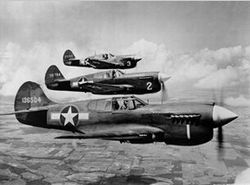 The original design of P-51s took 117 days, from
drawing on a napkin to finished aircraft. After all that, an
additional wait of six weeks was needed for the (Allison) engine to
arrive, as the bulk of those were going into P-40s (right) and
P-38s. One P-51 came out of production every 66 minutes. Over a
million hours were flown by P-51s. They were the first American
plane over Germany, and the first over Germany as a bomber escort,
although they didn't become the deadly useful tools we see today,
until the Brits, tired of waiting for Allison engines and
disappointed in their naturally-aspirated configuration, wrenched
the supercharged Rolls-Royce Merlin into the nose. We're told that
about 90% of Luftwaffe air-to-air losses were due to P-51s. After
WWII many P-51s were bought for around $1,500, and turned into air
racers. Many were restored today as air racers and as original
warbirds, with dozens more converted into the two-seat training
version. Of the 140 or so left, there are about 70 flying. (A
decent, used P-51D can usually be had for a million dollars today.
Set aside another million for the restoration, to make it
perfect.)
The original design of P-51s took 117 days, from
drawing on a napkin to finished aircraft. After all that, an
additional wait of six weeks was needed for the (Allison) engine to
arrive, as the bulk of those were going into P-40s (right) and
P-38s. One P-51 came out of production every 66 minutes. Over a
million hours were flown by P-51s. They were the first American
plane over Germany, and the first over Germany as a bomber escort,
although they didn't become the deadly useful tools we see today,
until the Brits, tired of waiting for Allison engines and
disappointed in their naturally-aspirated configuration, wrenched
the supercharged Rolls-Royce Merlin into the nose. We're told that
about 90% of Luftwaffe air-to-air losses were due to P-51s. After
WWII many P-51s were bought for around $1,500, and turned into air
racers. Many were restored today as air racers and as original
warbirds, with dozens more converted into the two-seat training
version. Of the 140 or so left, there are about 70 flying. (A
decent, used P-51D can usually be had for a million dollars today.
Set aside another million for the restoration, to make it
perfect.)
At one of the early conventions, Paul drove his "Red
One" VW Beetle past a man who was looking at the XP-51.
Stopping, he explained to the man what it was, how it flies, the
engine, and its use during the War. The gent stated "I tink it is
ze most beautiful plane effer constructed." Paul, noticing the
gent's German accent, asked who he was. "I am Ed Schmued," said the
designer of the aircraft! You never know whom you might meet at an
EAA AirVenture!
At the end of the evening, Paul committed the P-51 bearing his
name (below) to the EAA Museum. It won't be flown again.
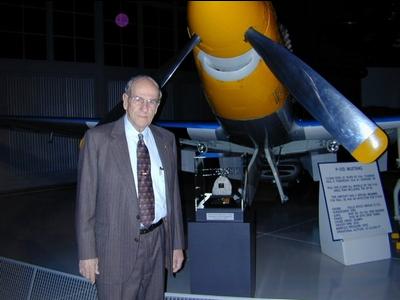
Early in the presentaion, a short film of the XP-51 and the P-64
was shown. The P-64 in the museum is the last of only 12 built.
North American also designed the T-6, bought by the Army Air Corps
en masse; the family resemblance is clear. The 11 P-64s left were
scrapped, and so Paul and EAA got the only one in the world.
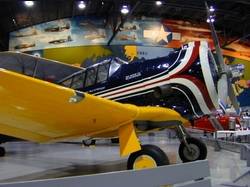 Paul has
flown the P-64 (right) with an acro group of Mustangs in the
background -- painted white with a red stripe. The P-51D "Paul 1"
flew at some of the early conventions, sometimes carrying a
passenger. One of the shots we saw that night has about a dozen
P-51s lined up in a row at an angle, so only turning props and hubs
can be seen.
Paul has
flown the P-64 (right) with an acro group of Mustangs in the
background -- painted white with a red stripe. The P-51D "Paul 1"
flew at some of the early conventions, sometimes carrying a
passenger. One of the shots we saw that night has about a dozen
P-51s lined up in a row at an angle, so only turning props and hubs
can be seen.
Been there, done that, got the video!
Hungry for more P-51 Mustang flying footage? EAA will have a
link at EAA.org to where you can purchase a tape of the night's
proceedings. Pricing hasn't been set as yet, but don't despair --
they'll come up with something! Oh -- when you watch the tape, make
sure to hook your TV to your HI-FI set so you can hear "the
greatest sound in the air!"
 ANN's Daily Aero-Term (04.25.24): Airport Rotating Beacon
ANN's Daily Aero-Term (04.25.24): Airport Rotating Beacon ANN's Daily Aero-Linx (04.25.24)
ANN's Daily Aero-Linx (04.25.24) Klyde Morris (04.22.24)
Klyde Morris (04.22.24) Airborne 04.24.24: INTEGRAL E, Elixir USA, M700 RVSM
Airborne 04.24.24: INTEGRAL E, Elixir USA, M700 RVSM Airborne 04.22.24: Rotor X Worsens, Airport Fees 4 FNB?, USMC Drone Pilot
Airborne 04.22.24: Rotor X Worsens, Airport Fees 4 FNB?, USMC Drone Pilot











